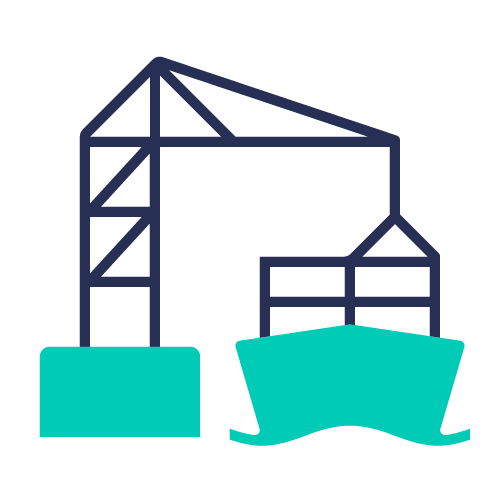Comets, meteorites, asteroids… to many people these are the threats coming from outer space to be most wary of. But the most likely threat to our way of life on Earth is something we also rely on for survival: the Sun.
Extreme space weather
A solar storm is a sudden and intense burst of radiation and energetic particles blasted from the Sun. If large enough and directed towards Earth, the resulting ‘space weather’ has the potential to severely damage critical infrastructure and create significant disruption across multiple industries and our everyday activities.
Solar storms are a powerful phenomenon that occur when the Sun’s complex and twisted magnetic field releases huge amounts of energy. This can result in intense bursts of light called ‘solar flares’, superheated plasma known as a ‘coronal mass ejections’ (CMEs)[1], or highly charged particles being blasted into space. When these eruptions interact with the Earth’s natural magnetic field, they can create geomagnetic storms that have the potential to disrupt the digital systems we heavily rely on in our modern way of life.
These effects can look magnificent when they create dazzling aurora displays in our skies, but historical precedent suggests the impacts of this natural catastrophe could materially affect the global economy. The 1859 Carrington Event is the largest recorded solar storm. Seventeen hours after Astronomer Richard Carrington saw a solar flare through his telescope, an enormous and unprecedented geomagnetic storm was creating worldwide disruption on Earth, including damaging telegraph wires and igniting fires at telegraph stations in North America and Europe.[2]
Technology and communications infrastructure is no longer in its infancy. If this event happened today, it could cause significant disruption across energy grids, satellites, navigation systems, and communication, transportation and financial networks – vital systems relied upon daily by businesses, governments and society globally.
As we continue to race forwards into a digital future, it’s critical we are vigilant in understanding the risks posed by space weather. The cost of preparedness is far smaller than the cost of inaction, and building resilience is essential for protecting the global economy from the forces of the Sun.
[1] https://www.usgs.gov/news/featured-story/5-geomagnetic-storms-reshaped-society
[2] https://www.space.com/the-carrington-event

© Max Alexander/Lloyd’s “Life in the Sun’s Atmosphere”, please note a credit is required to use this image
The value of insurance
At Lloyd’s we have a rich history of insuring the space industry, dating back to the Earlybird satellite in 1965. However space weather can damage assets on Earth as well as in space, and cause knock-on disruption across all industries that rely on communications, navigation or power systems.
Space weather is therefore an evolving area of coverage with a wide spectrum of financial support and protection. Some examples include:

Property insurance
Infrastructure, buildings and equipment are all vulnerable to damage caused by power surges and electrical fires during a solar storm. Property insurance helps businesses manage these risks by covering for the costs of repair or replacement for damaged infrastructure.

Business interruption insurance
Reliance on technology, power and communication connectivity means that in the face of a power outage or GNSS disruption, business operations can come to a standstill. Business interruption insurance provides coverage for the extra costs involved with getting back online and income lost during the downtime, after a defined interruption period has passed.

Energy insurance
A geomagnetic storm could overload transformers and cause cascading failures in the electricity grid. Energy insurance provides critical financial support to energy suppliers and operators by covering the costs associated with machinery breakdown and repair or replacement of damaged energy-related infrastructure.

Aviation insurance
Aviation insurance can minimise the impact to airport services and help maintain passenger trust by addressing the damages and delays that may arise due to disruptions to GNSS navigation and communication systems. Insurance can provide financial compensation for damages to aircraft and aerospace systems and third-party liabilities from delays or injuries.

Marine cargo insurance
Disruption to GNSS can mean ships are forced to remain stationary until systems regain signal. These delays can be costly, especially if time-sensitive cargo, such as food or pharmaceuticals, expire and are spoiled. Marine cargo insurance includes a range of covers that can provide financial protection against losses arising from physical damage to cargo, and related liabilities while it is in transit by sea and in storage.
Find out more about how insurance can help build resilience against the effects of space weather and covers available using the link below.

Picture the scene: A major solar storm unfolds
The Sun’s complex magnetic field follows an 11-year solar cycle and alternating periods of high and low activity. Our Sun is currently in its periodic high cycle – Solar Cycle 25 - which is set to peak in July 2025[3], increasing the likelihood of extreme space weather.
This hypothetical scenario explores how a large, rare solar storm that collides with Earth’s magnetic field could unfold into a costly event.
Sighting
Solar scientists at an observatory see increased sunspot activity, highlighting a potential threat to Earth. They alert governments and critical infrastructure operators, and some implement pre-planned resilience arrangements.
Timeframe: Hours

Eruption
High solar activity continues, resulting in a release of energy that sees very large coronal mass ejections (CMEs) thrown out towards Earth.
Timeframe: Hours

Bombardment
For an hour Earth is hit with a Carrington-level geomagnetic storm, the most intense ever recorded. This is joined by numerous substorms forming every few hours on the daylight side of the planet.
Timeframe: One Hour

Interference
The build-up of charged particles trapped within the Earth’s magnetic field causes signal scintillation (rapid changes in amplitude and signal phasing) which inhibits communication signals from satellites - including those used for Global Navigation Satellite Systems (GNSS) - from reaching users on the ground[4].
[4] https://raeng.org.uk/media/lz2fs5ql/space_weather_full_report_final.pdf
Timeframe: Hours

Stress
On Earth, the geomagnetic storm induces high electric currents along electricity cables, while in space the solar arrays that satellites rely on for power begin to degrade. Thanks to the mitigation actions taken, both satellites and energy grids weather the initial assault, however satellites with design or manufacturing defects may be susceptible to space weather effects.
Timeframe: Hours

Burn-out
Eventually, wiring and sensitive extra high voltage (EHV) components across the energy grid are damaged beyond repair, leaving the grid unable to take the heightened induced currents. Nodes collapse and remaining electrical assets fold under very large loads resulting in cascading failure. This leads to power outages across whole regions and major industrial centres. In space, numerous satellites in geostationary orbit lose power or re-enter low Earth orbit (LEO), increasing their risk of collision.
Timeframe: Weeks

Consequences
With key satellite constellations failing and GNSS interrupted, global aviation and shipping grind to a halt. Meanwhile power surges across the energy grid cause cabling at industrial sites to overheat, igniting fires and force high demand on to emergency services. Supply chains are unable to respond to the volume of repairs required, resulting in a sustained reduction in capacity (or even outages) across critical communication, navigation and power services.
Timeframe: Weeks - months
The severity of events and impacts
Not every solar storm will create such widespread disruption. There are differing levels of severity - from a major event that causes localised and temporary system errors and outages, to extreme events that may be much longer lasting and have the potential to paralyse critical infrastructure systems worldwide.
| Level | Scenario severity descriptions | Historical reference (magnitude) |
| Major | Strong geomagnetic storm: Planes and passengers at high altitude may be exposed to limited radiation. Satellite systems have memory problems and noise on imaging systems, GNSS become prone to error, high frequency (HF) radio communications blackout. Some low-level electrical interference and voltage control problems. Less than a week of disruption. | 1989 Geomagnetic Storm (G4) |
| Severe | Severe geomagnetic storm: Planes and passengers at high altitude are exposed to radiation. Satellite systems have memory device problems and noise on imaging systems, GNSS are prone to error, and there is a blackout of HF radio communications. Widespread voltage problems and power grids tripping in certain regions. Over a week of disruption caused. | 1859 Carrington Event (G5) |
| Extreme | Extreme geomagnetic storm: Large radiation exposure to passengers and crew in commercial jets at high altitude. Satellites rendered useless, GNSS failure and serious noise on imaging systems is seen. Telecommunication systems fail and widespread voltage control and protective system problems occur. Some grid systems experience complete collapse or blackouts. Transformers may experience damage. | 2012 solar superstorm (G5) (if it hadn’t missed Earth) |
Historical references
- 1859, Carrington Event: Intense geomagnetic storms caused the Northern Lights to be observed as far south as the Caribbean. The high level of energy in the atmosphere caused fire damage to telegraph cables and offices globally. It is noted that some telegraph communications continued to function throughout the storm despite equipment being disconnected, due to atmospheric energy.
- 1989, Geomagnetic storm: A significant storm which caused the Hydro-Québec power grid to collapse in less than 90 seconds, leaving 6 million people without electricity for 9 hours. New York Power and New England Power also suffered knock-on reductions in wattage. The Space Shuttle Discovery, which was in orbit at the time, experienced sensor malfunctions due to the increased particle activity.[5]
- 2003, Halloween Storms: During Solar Cycle 23, a mix of CMEs and 17 solar flares hit Earth’s magnetic field. The largest flare was X45 class, the most powerful the Sun can produce[6]. This led to a one-hour power outage in parts of Scandinavia and a radio blackout of high-frequency communication stations and the Global Positioning System (GPS). Flights also detoured to lower latitudes to avoid radiation, at great expense to airlines. Many satellites in low Earth orbit (LEO) were temporarily “lost” and it was days later before their positions were reestablished.[7]
- 2012, Carrington-class solar storm: An observed massive solar superstorm missed Earth is thought to be the most powerful of its kind to occur since Carrington. The CME travelled over 1,800 miles per second, the fastest recorded speed[8]. In 2014, an academic from the University of Colorado noted: “if it had hit us, we would still be picking up the pieces”.
- 2024, Geomagnetic storm: In May 2024, we saw what was categorised a level G5 event – the strongest on the geomagnetic storm scale – triggered by large solar flares and at least seven CMEs hurtling towards Earth. Earth’s magnetic field shields us from the most severe impacts, as was the case on this occasion[9], however there were failures across GPS systems used for precision farming, and both power grid and satellite operators were forced to implement precautionary measures to protect their equipment.
[5] https://web.archive.org/web/20220313220247/http://www.nasa.gov/topics/earth/features/sun_darkness.html
[6] https://www.livescience.com/space/the-sun/historic-space-photo-a-monstrous-halloween-storm-explodes-from-the-sun
[7] https://spaceweatherarchive.com/2021/10/28/the-day-earth-lost-half-its-satellites-halloween-storms-2003/
[8] https://svs.gsfc.nasa.gov/12142/
[9] https://www.esa.int/Space_Safety/Space_weather/The_May_2024_solar_storm_your_questions_answered

© Max Alexander/Lloyd’s “Life in the Sun’s Atmosphere”, please note a credit is required to use this image
Scenario effects
The economic impacts from this scenario primarily arise from damage to critical infrastructure and the resulting business interruption across industries that rely on it.
Damage to sensitive EHV transformers - crucial for efficiently transporting electricity over long distances - is the most serious and time-consuming effect of this scenario. If transformers overheat due to exposure to geomagnetically induced currents (GICs), this can lead to failures on the electrical grid and potentially widespread and prolonged blackouts across regions. Hospitals, homes and businesses could go dark and cold without power, and substantial power outages in major markets could have a significant economic impact on international business through lost productivity, cessation of business operations, loss of or stranded goods, transport delays and disruptions.
Satellites and other spacecraft are likely to be physically damaged or experience anomalies, with a knock-on impact on digital and communication networks. It is possible that this could trigger an internet blackout in some regions, which could also lead to increased vulnerability to cyber-attacks if threat actors respond quickly and attack during system reboots. This scenario does not consider the long-term degradation costs to satellites.
In the most severe level of the scenario, GNSS are temporarily knocked out. Impacts to location accuracy and operational precision could mean flights are grounded, ships are stalled, construction projects delayed, financial transactions halted, and trade slowed. Existing political tensions could be exacerbated as countries fight for key resources needed to recuperate from the attack, stalling economic recovery. Social disorder, such as looting, could also arise as disruption creates a desperation for food, cash and other essentials.
The scenario also presents health risks. Passengers and crew on flights could be exposed to radiation levels 20 times the annual limit, translating to an increased lifetime cancer risk of 1 in 1,000 for each person exposed[10].
[10] https://raeng.org.uk/media/lz2fs5ql/space_weather_full_report_final.pdf
Explore the impacts
The economic impact
The role of insurance
Disclaimer
This report has been produced by Lloyd's Futureset and Cambridge Centre for Risk Studies for general information purposes only.
While care has been taken in gathering the data and preparing the report Lloyd's and Cambridge Centre for Risk Studies do not, severally or jointly, make any representations or warranties on behalf of themselves or others as to its accuracy or completeness and expressly exclude to the maximum extent permitted by law all those that might otherwise be implied.
Lloyd's and Cambridge Centre for Risk Studies accept no responsibility or liability for any loss or damage of any nature occasioned to any person as a result of acting or refraining from acting as a result of, or in reliance on, any statement, fact, figure or expression of opinion or belief contained in this report. This report does not constitute advice of any kind.
Note that this report does not seek to replace or inform any of the mandatory scenarios which Lloyd’s publishes to support the Realistic Disaster Scenario exercises managing agents are required to undertake in respect of the syndicates managed by them.





